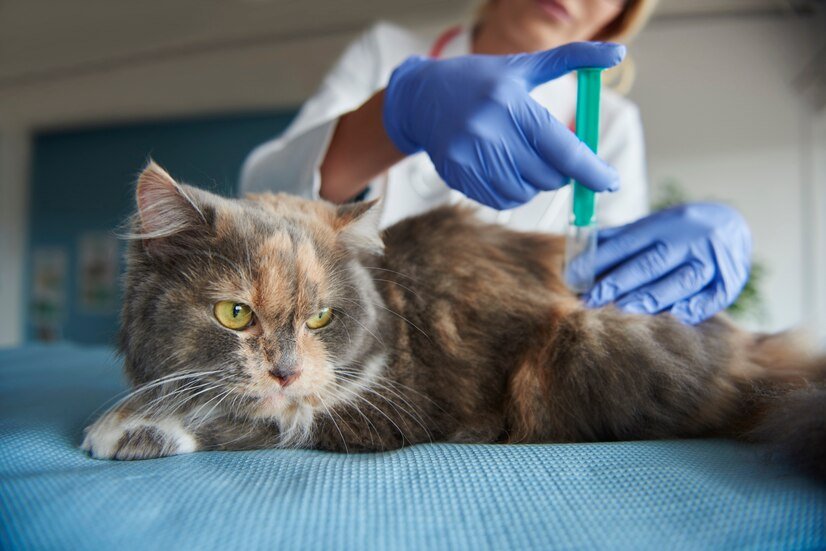Welcome, cat owners! If you’re here, it means you care about the health and well-being of your furry feline friend. And let’s face it, our cats are like family to us. That’s why it’s crucial to stay informed about essential vaccinations that can protect them from potentially harmful diseases.
One such vaccine is the FVRCP vaccine. But what exactly does FVRCP stand for? How often should your cat receive this vaccination? Are there any side effects to be aware of? And most importantly, why is the FVRCP considered a core vaccine for cats?
In this blog post, we’ll dive into all things FVRCP and answer these burning questions. So grab a cup of tea (or maybe a saucer of milk), sit back, and let’s unravel the mysteries surrounding the FVRCP cat vaccine together!
Table of Contents
What Is the FVRCP Cat Vaccine?
The FVRCP cat vaccine is a vital immunization that helps protect our furry friends from three common and potentially serious feline diseases: Feline Viral Rhinotracheitis (FVR), Feline Calicivirus (FCV), and Feline Panleukopenia (FP). These diseases can lead to respiratory problems, oral ulcers, severe gastrointestinal issues, and even death.
The vaccine works by stimulating the cat’s immune system to produce antibodies against these viruses. By doing so, it prepares their body to fight off potential infections if they come into contact with the actual viruses in the future. Administered through an injection, this vaccine plays a crucial role in preventing these highly contagious diseases from spreading among cats in households or communities.
What Does FVRCP Stand For?
The acronym FVRCP stands for Feline Viral Rhinotracheitis, Calicivirus, and Panleukopenia. These are three highly contagious viral diseases that can affect cats of all ages.
Feline Viral Rhinotracheitis (FVR) is caused by the feline herpesvirus and primarily affects the respiratory system. It can cause symptoms such as sneezing, nasal discharge, coughing, and conjunctivitis. Feline Calicivirus (FCV) is another common respiratory infection that can lead to mouth ulcers, fever, lethargy, and lameness in cats. Feline Panleukopenia (FP), also known as feline distemper or parvo virus, attacks the gastrointestinal tract and immune system of cats.
These three diseases are commonly grouped together because they are often vaccinated against at the same time with the FVRCP vaccine to provide comprehensive protection for your furry friend’s health.
Why Is the FVRCP Vaccine Considered a Core Vaccine for Cats?
The FVRCP vaccine is considered a core vaccine for cats because it protects against three highly contagious and potentially deadly diseases: feline viral rhinotracheitis, feline calicivirus, and feline panleukopenia. These diseases can easily spread among cats, especially those in close quarters like shelters or multi-cat households.
Feline viral rhinotracheitis is caused by the herpesvirus and primarily affects the respiratory system. It can lead to symptoms such as sneezing, nasal discharge, coughing, and conjunctivitis. Feline calicivirus also affects the respiratory system but can also cause oral ulcers and lameness. Feline panleukopenia is a severe gastrointestinal disease that can result in vomiting, diarrhea, dehydration, and even death.
Administering the FVRCP vaccine helps prevent these diseases from infecting your cat. By keeping your cat up-to-date on their vaccinations, you are not only protecting them from potential illness but also helping to control the spread of these viruses within the feline population.
How Often Should My Cat Receive the FVRCP Vaccine?
How often should my cat receive the FVRCP vaccine? This is a common question among cat owners, and it’s important to understand the recommended vaccination schedule.
The FVRCP vaccine is typically given to kittens starting at around 6-8 weeks of age, with boosters administered every 3-4 weeks until they are about 16 weeks old. After that initial series of vaccinations, adult cats generally receive a booster shot one year later. Following this, most veterinarians recommend giving the FVRCP vaccine every three years to maintain protection against these diseases.
It’s worth noting that some factors may influence the frequency of vaccination for individual cats. For example, outdoor cats or those in high-risk environments may require more frequent vaccinations compared to indoor-only cats. Your veterinarian can help determine the best schedule for your feline friend based on their lifestyle and potential exposure to infectious diseases. Keeping your cat up-to-date on their vaccines is an essential part of responsible pet ownership and helps ensure their overall health and well-being!
Does the FVRCP Have Any Side Effects?
The FVRCP vaccine, like any other medication, can potentially have side effects in some cats. However, it’s important to note that serious side effects are rare and most cats tolerate the vaccine without any issues. Some common side effects that may occur include mild fever, lethargy, and soreness at the injection site. These reactions typically resolve on their own within a few days.
In very rare cases, more severe allergic reactions such as facial swelling or difficulty breathing may occur. If you notice any unusual or concerning symptoms after your cat receives the FVRCP vaccine, it’s important to contact your veterinarian immediately for further guidance. While there is a small risk of side effects with the FVRCP vaccine, the benefits of protecting your cat against potentially life-threatening diseases far outweigh this minimal risk.
How Much Does the FVRCP Cat Vaccine Cost?
The cost of the FVRCP cat vaccine can vary depending on several factors. On average, you can expect to pay around $20 to $30 per dose of the vaccine. However, it’s important to note that your cat may require multiple doses over a specific period of time.
Factors that can influence the cost include the location and type of veterinary clinic you visit, as well as any additional services or examinations that may be required during your cat’s vaccination appointment. It’s always a good idea to contact your veterinarian ahead of time to get an estimate of the total cost and discuss any potential payment options or discounts that may be available.
Feline Viral Rhinotracheitis
Feline Viral Rhinotracheitis, also known as FVR, is a highly contagious respiratory disease that affects cats. It is caused by the feline herpesvirus-1 (FHV-1) and primarily targets the upper respiratory system. Cats infected with FVR may exhibit symptoms such as sneezing, nasal discharge, conjunctivitis, coughing, and fever.
The virus can be spread through direct contact with an infected cat or through contaminated objects such as food bowls or litter boxes. It can also be transmitted through airborne droplets from sneezing or coughing. Kittens and older cats with weakened immune systems are particularly susceptible to FVR. Vaccination against this disease is essential in preventing its spread and protecting your cat’s health.
Feline Calicivirus
Feline Calicivirus, or FCV for short, is a highly contagious viral infection that affects cats. It belongs to the family of viruses called Caliciviridae and can cause respiratory and oral problems in infected felines.
The virus spreads through direct contact with an infected cat or by coming into contact with contaminated objects such as food bowls or litter boxes. Symptoms of FCV can vary but commonly include sneezing, nasal discharge, ulcers in the mouth, lameness, and fever. In severe cases, it can lead to pneumonia or even death. Vaccination against Feline Calicivirus is essential to protect your furry friend from this potentially serious illness.
Feline Panleukopenia
Feline Panleukopenia, also known as feline distemper, is a highly contagious and potentially life-threatening viral infection in cats. It primarily affects the gastrointestinal tract, bone marrow, and lymphoid tissues. The virus can survive in the environment for long periods, making it easy to spread among cats.
Symptoms of Feline Panleukopenia include fever, lethargy, loss of appetite, vomiting, diarrhea (often bloody), dehydration, and a weakened immune system. Kittens are particularly susceptible to severe cases of this disease and may not survive if left untreated.
Thankfully, the FVRCP vaccine offers protection against Feline Panleukopenia along with other important viruses. By ensuring that your cat receives regular vaccinations throughout their life, you significantly reduce their risk of contracting this deadly disease.
Remember to consult with your veterinarian about the appropriate vaccination schedule for your cat based on their individual needs and lifestyle factors. Vaccination guidelines may vary depending on age and health status.
The FVRCP vaccine is an essential part of preventative healthcare for cats. It protects against three key viruses: Feline Viral Rhinotracheitis (herpesvirus-1), which causes respiratory infections; Feline Calicivirus (FCV), which causes upper respiratory infections; and Feline Panleukopenia (FPV), a highly contagious viral disease affecting multiple body systems.
Regular vaccination helps ensure that your beloved feline companion stays healthy by reducing the risk of these diseases spreading within communities or households where multiple cats reside.
While vaccines are generally safe and effective at preventing diseases like those covered by the FVRCP vaccine, it’s always important to be aware of potential side effects or adverse reactions. If you notice any unusual symptoms following vaccination or have concerns about your cat’s health after receiving vaccines, contact your veterinarian immediately.
Understanding the importance of vaccinations such as the FVRCP vaccine is crucial for every cat owner.



